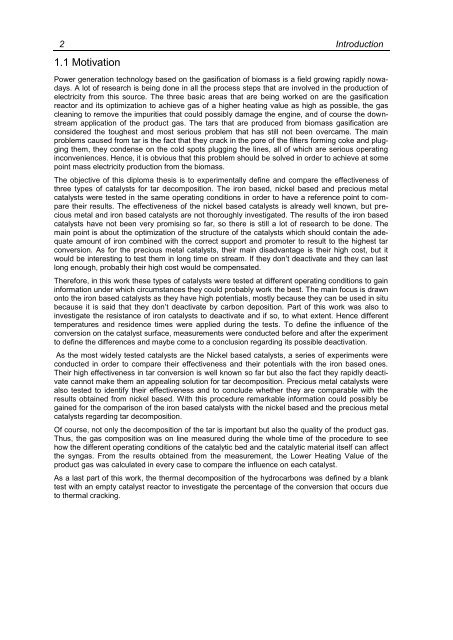Dipl. Ing. Matthias Mayerhofer Technische Universität München ...
Dipl. Ing. Matthias Mayerhofer Technische Universität München ...
Dipl. Ing. Matthias Mayerhofer Technische Universität München ...
You also want an ePaper? Increase the reach of your titles
YUMPU automatically turns print PDFs into web optimized ePapers that Google loves.
2 Introduction<br />
1.1 Motivation<br />
Power generation technology based on the gasification of biomass is a field growing rapidly nowadays.<br />
A lot of research is being done in all the process steps that are involved in the production of<br />
electricity from this source. The three basic areas that are being worked on are the gasification<br />
reactor and its optimization to achieve gas of a higher heating value as high as possible, the gas<br />
cleaning to remove the impurities that could possibly damage the engine, and of course the downstream<br />
application of the product gas. The tars that are produced from biomass gasification are<br />
considered the toughest and most serious problem that has still not been overcame. The main<br />
problems caused from tar is the fact that they crack in the pore of the filters forming coke and plugging<br />
them, they condense on the cold spots plugging the lines, all of which are serious operating<br />
inconveniences. Hence, it is obvious that this problem should be solved in order to achieve at some<br />
point mass electricity production from the biomass.<br />
The objective of this diploma thesis is to experimentally define and compare the effectiveness of<br />
three types of catalysts for tar decomposition. The iron based, nickel based and precious metal<br />
catalysts were tested in the same operating conditions in order to have a reference point to compare<br />
their results. The effectiveness of the nickel based catalysts is already well known, but precious<br />
metal and iron based catalysts are not thoroughly investigated. The results of the iron based<br />
catalysts have not been very promising so far, so there is still a lot of research to be done. The<br />
main point is about the optimization of the structure of the catalysts which should contain the adequate<br />
amount of iron combined with the correct support and promoter to result to the highest tar<br />
conversion. As for the precious metal catalysts, their main disadvantage is their high cost, but it<br />
would be interesting to test them in long time on stream. If they don’t deactivate and they can last<br />
long enough, probably their high cost would be compensated.<br />
Therefore, in this work these types of catalysts were tested at different operating conditions to gain<br />
information under which circumstances they could probably work the best. The main focus is drawn<br />
onto the iron based catalysts as they have high potentials, mostly because they can be used in situ<br />
because it is said that they don’t deactivate by carbon deposition. Part of this work was also to<br />
investigate the resistance of iron catalysts to deactivate and if so, to what extent. Hence different<br />
temperatures and residence times were applied during the tests. To define the influence of the<br />
conversion on the catalyst surface, measurements were conducted before and after the experiment<br />
to define the differences and maybe come to a conclusion regarding its possible deactivation.<br />
As the most widely tested catalysts are the Nickel based catalysts, a series of experiments were<br />
conducted in order to compare their effectiveness and their potentials with the iron based ones.<br />
Their high effectiveness in tar conversion is well known so far but also the fact they rapidly deactivate<br />
cannot make them an appealing solution for tar decomposition. Precious metal catalysts were<br />
also tested to identify their effectiveness and to conclude whether they are comparable with the<br />
results obtained from nickel based. With this procedure remarkable information could possibly be<br />
gained for the comparison of the iron based catalysts with the nickel based and the precious metal<br />
catalysts regarding tar decomposition.<br />
Of course, not only the decomposition of the tar is important but also the quality of the product gas.<br />
Thus, the gas composition was on line measured during the whole time of the procedure to see<br />
how the different operating conditions of the catalytic bed and the catalytic material itself can affect<br />
the syngas. From the results obtained from the measurement, the Lower Heating Value of the<br />
product gas was calculated in every case to compare the influence on each catalyst.<br />
As a last part of this work, the thermal decomposition of the hydrocarbons was defined by a blank<br />
test with an empty catalyst reactor to investigate the percentage of the conversion that occurs due<br />
to thermal cracking.
















